Corporate Accounting Analysis of Wesfarmers' Financial Statements
VerifiedAdded on 2021/05/31
|9
|866
|14
Report
AI Summary
This report provides a detailed analysis of Wesfarmers Limited's corporate accounting practices. It begins with an examination of the cash flow statement, highlighting the company's activities in operations, investment, and financing. The analysis notes changes in investment activities due to asset sales and discusses the impact of loan terms on borrowing transactions. The report then delves into the other comprehensive income statement, outlining components such as foreign currency translation and retained earnings. It further explores the accounting for corporate income tax, including Wesfarmers' tax rate, tax assets, and liabilities, with a comparison of figures from income and cash flow statements. The report references the company's adherence to Australian tax regulations and identifies key dynamics influencing its tax treatment. References to relevant academic literature are included to support the analysis.
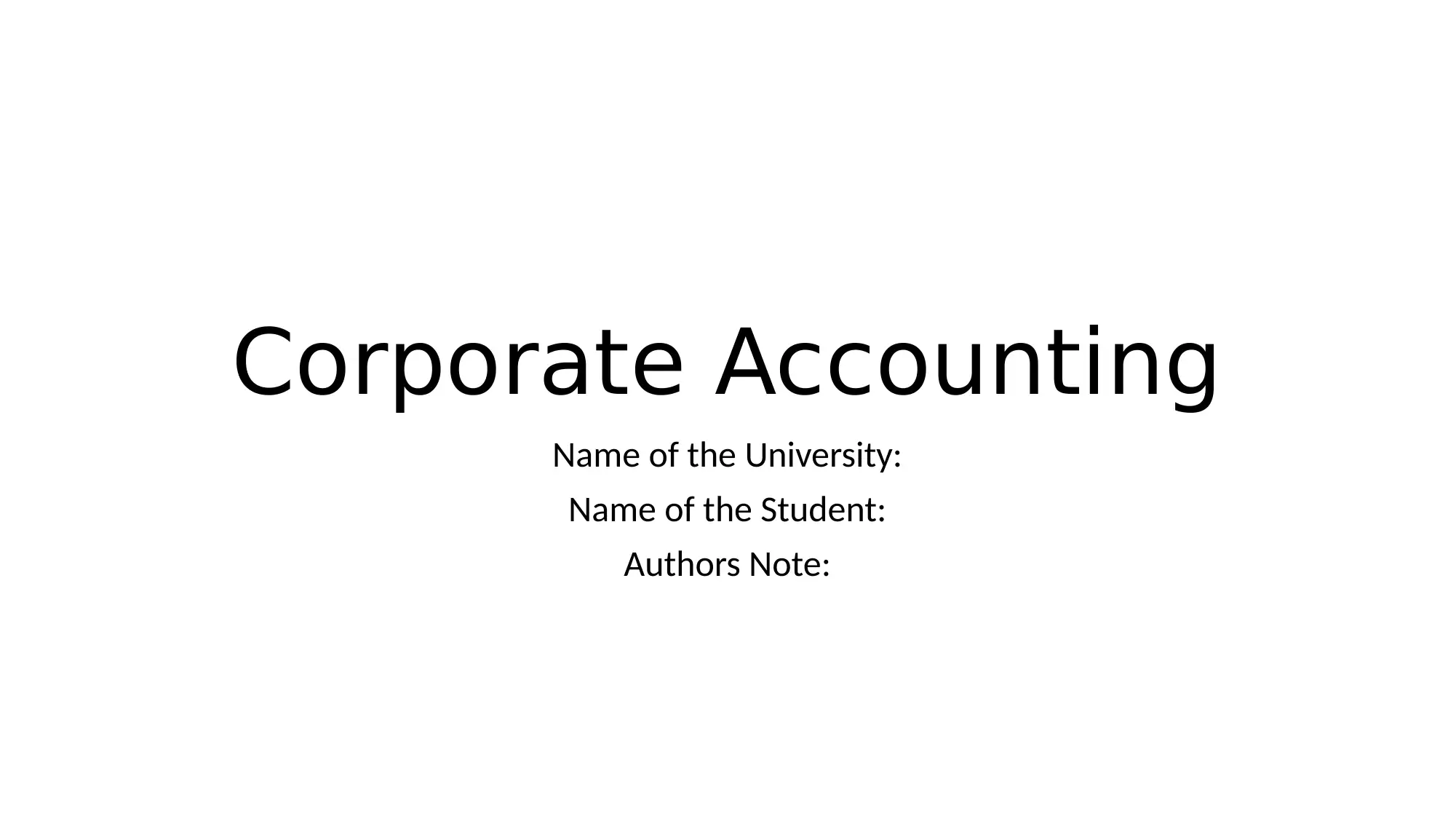
Corporate Accounting
Name of the University:
Name of the Student:
Authors Note:
Name of the University:
Name of the Student:
Authors Note:
Paraphrase This Document
Need a fresh take? Get an instant paraphrase of this document with our AI Paraphraser
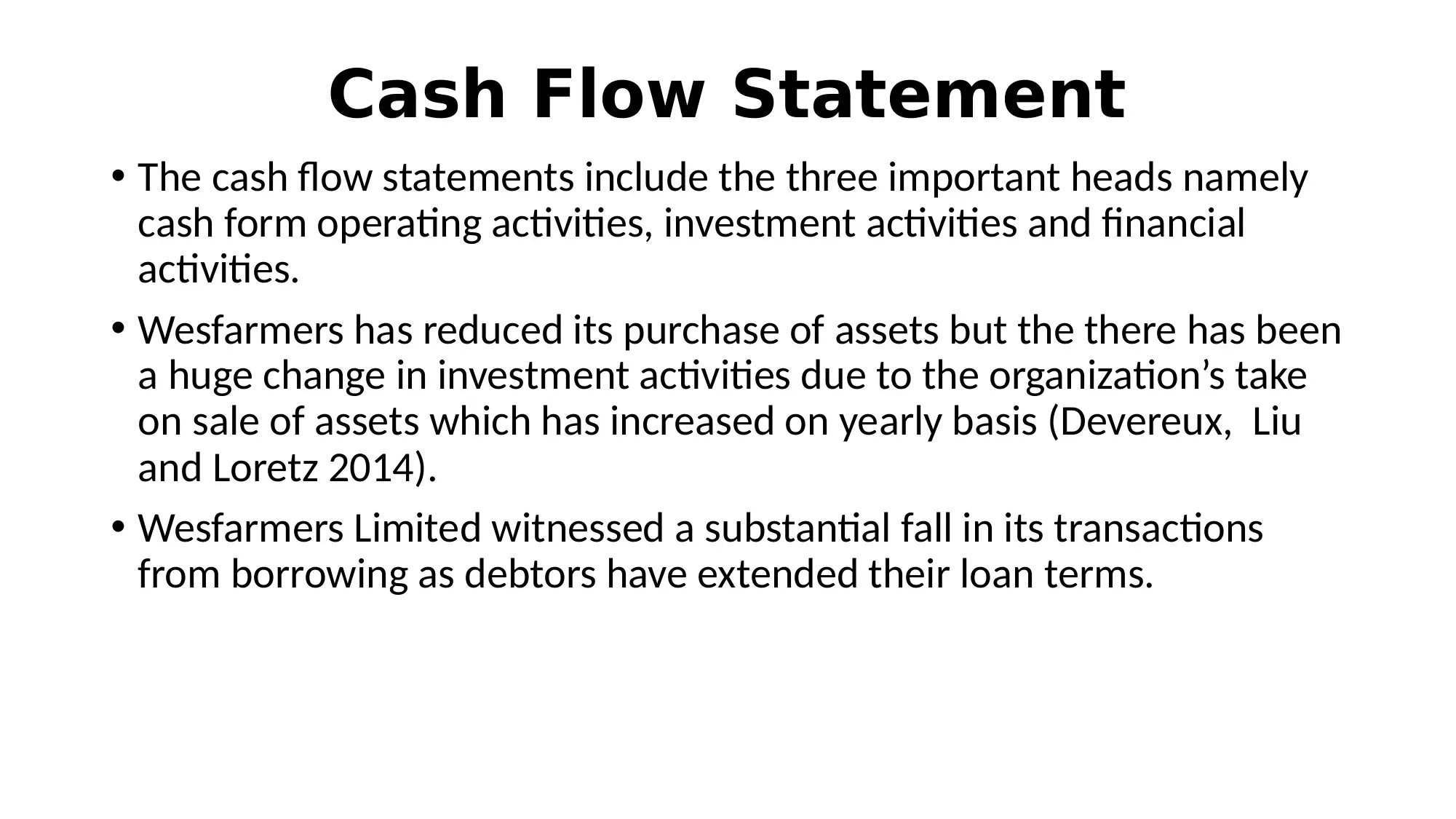
Cash Flow Statement
• The cash flow statements include the three important heads namely
cash form operating activities, investment activities and financial
activities.
• Wesfarmers has reduced its purchase of assets but the there has been
a huge change in investment activities due to the organization’s take
on sale of assets which has increased on yearly basis (Devereux, Liu
and Loretz 2014).
• Wesfarmers Limited witnessed a substantial fall in its transactions
from borrowing as debtors have extended their loan terms.
• The cash flow statements include the three important heads namely
cash form operating activities, investment activities and financial
activities.
• Wesfarmers has reduced its purchase of assets but the there has been
a huge change in investment activities due to the organization’s take
on sale of assets which has increased on yearly basis (Devereux, Liu
and Loretz 2014).
• Wesfarmers Limited witnessed a substantial fall in its transactions
from borrowing as debtors have extended their loan terms.
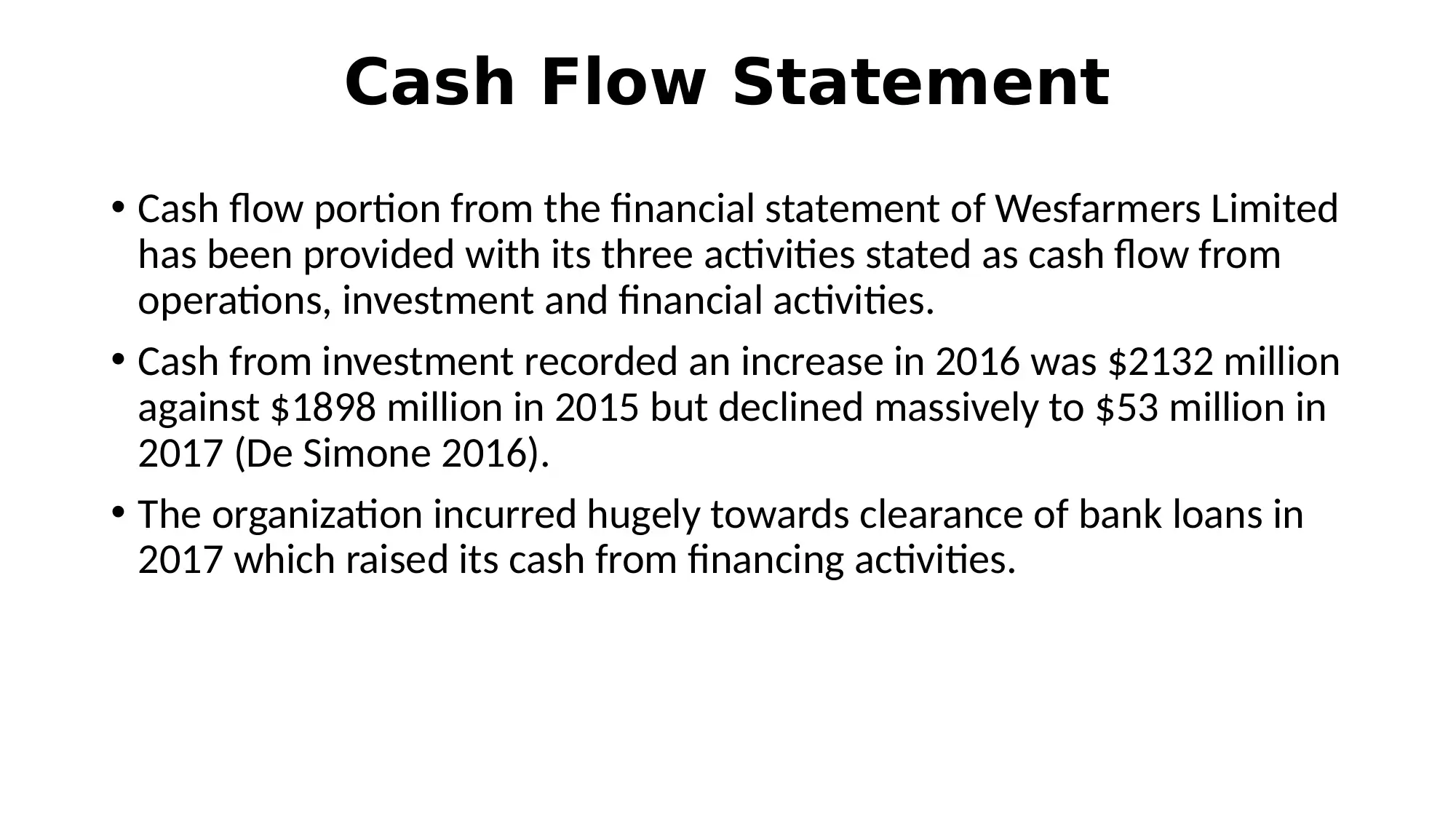
Cash Flow Statement
• Cash flow portion from the financial statement of Wesfarmers Limited
has been provided with its three activities stated as cash flow from
operations, investment and financial activities.
• Cash from investment recorded an increase in 2016 was $2132 million
against $1898 million in 2015 but declined massively to $53 million in
2017 (De Simone 2016).
• The organization incurred hugely towards clearance of bank loans in
2017 which raised its cash from financing activities.
• Cash flow portion from the financial statement of Wesfarmers Limited
has been provided with its three activities stated as cash flow from
operations, investment and financial activities.
• Cash from investment recorded an increase in 2016 was $2132 million
against $1898 million in 2015 but declined massively to $53 million in
2017 (De Simone 2016).
• The organization incurred hugely towards clearance of bank loans in
2017 which raised its cash from financing activities.
⊘ This is a preview!⊘
Do you want full access?
Subscribe today to unlock all pages.

Trusted by 1+ million students worldwide
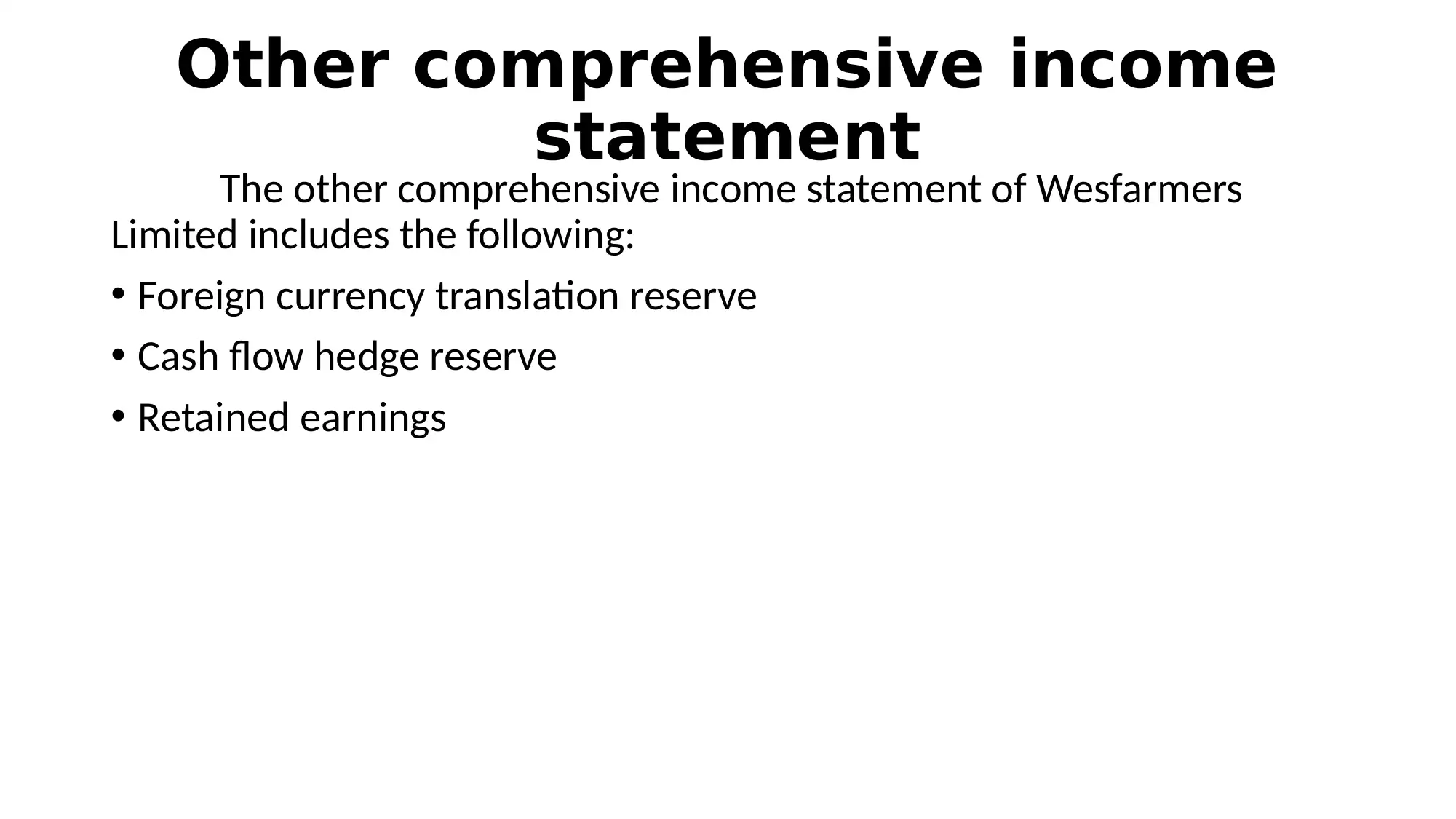
Other comprehensive income
statement
The other comprehensive income statement of Wesfarmers
Limited includes the following:
• Foreign currency translation reserve
• Cash flow hedge reserve
• Retained earnings
statement
The other comprehensive income statement of Wesfarmers
Limited includes the following:
• Foreign currency translation reserve
• Cash flow hedge reserve
• Retained earnings
Paraphrase This Document
Need a fresh take? Get an instant paraphrase of this document with our AI Paraphraser
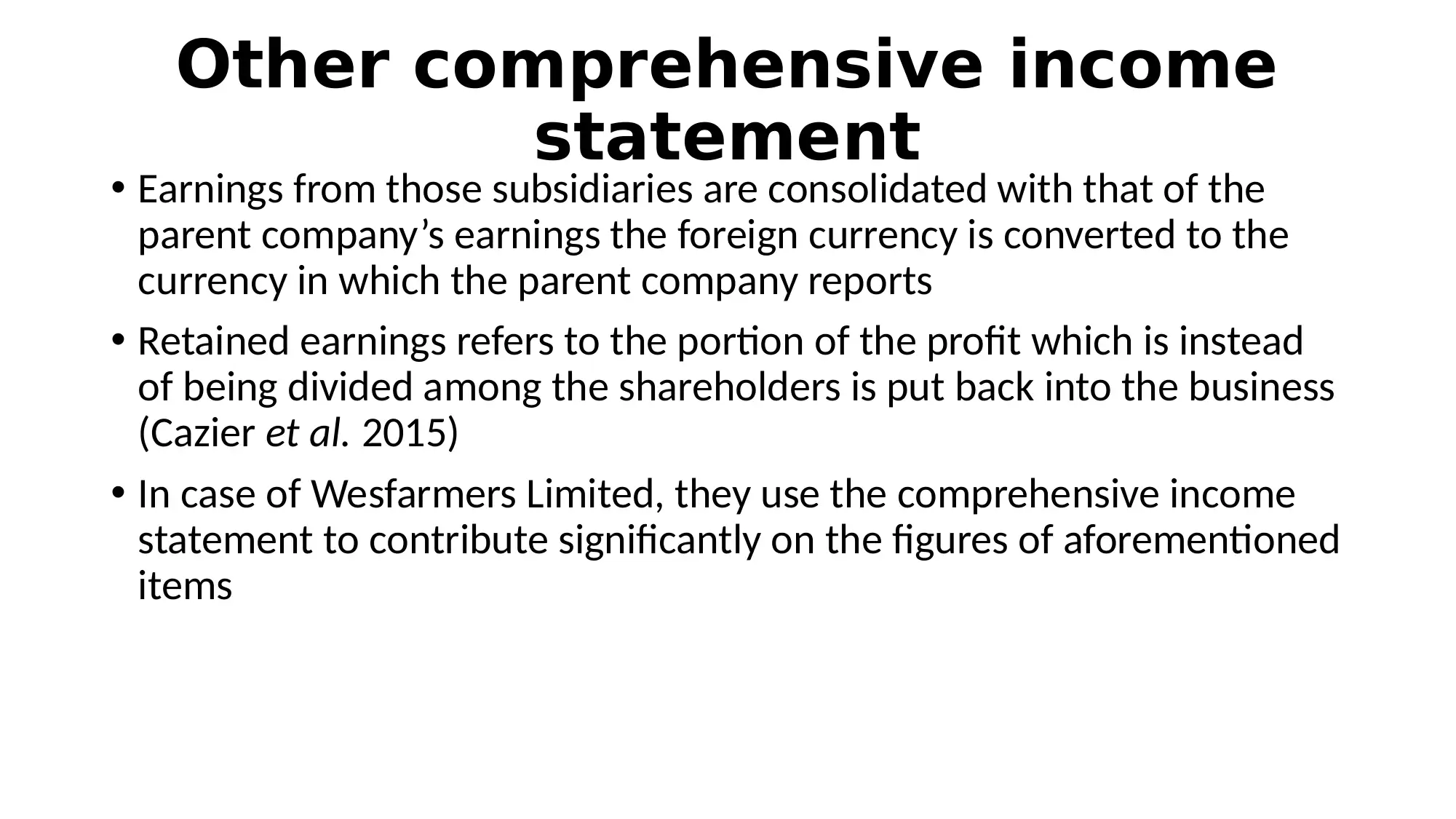
Other comprehensive income
statement
• Earnings from those subsidiaries are consolidated with that of the
parent company’s earnings the foreign currency is converted to the
currency in which the parent company reports
• Retained earnings refers to the portion of the profit which is instead
of being divided among the shareholders is put back into the business
(Cazier et al. 2015)
• In case of Wesfarmers Limited, they use the comprehensive income
statement to contribute significantly on the figures of aforementioned
items
statement
• Earnings from those subsidiaries are consolidated with that of the
parent company’s earnings the foreign currency is converted to the
currency in which the parent company reports
• Retained earnings refers to the portion of the profit which is instead
of being divided among the shareholders is put back into the business
(Cazier et al. 2015)
• In case of Wesfarmers Limited, they use the comprehensive income
statement to contribute significantly on the figures of aforementioned
items
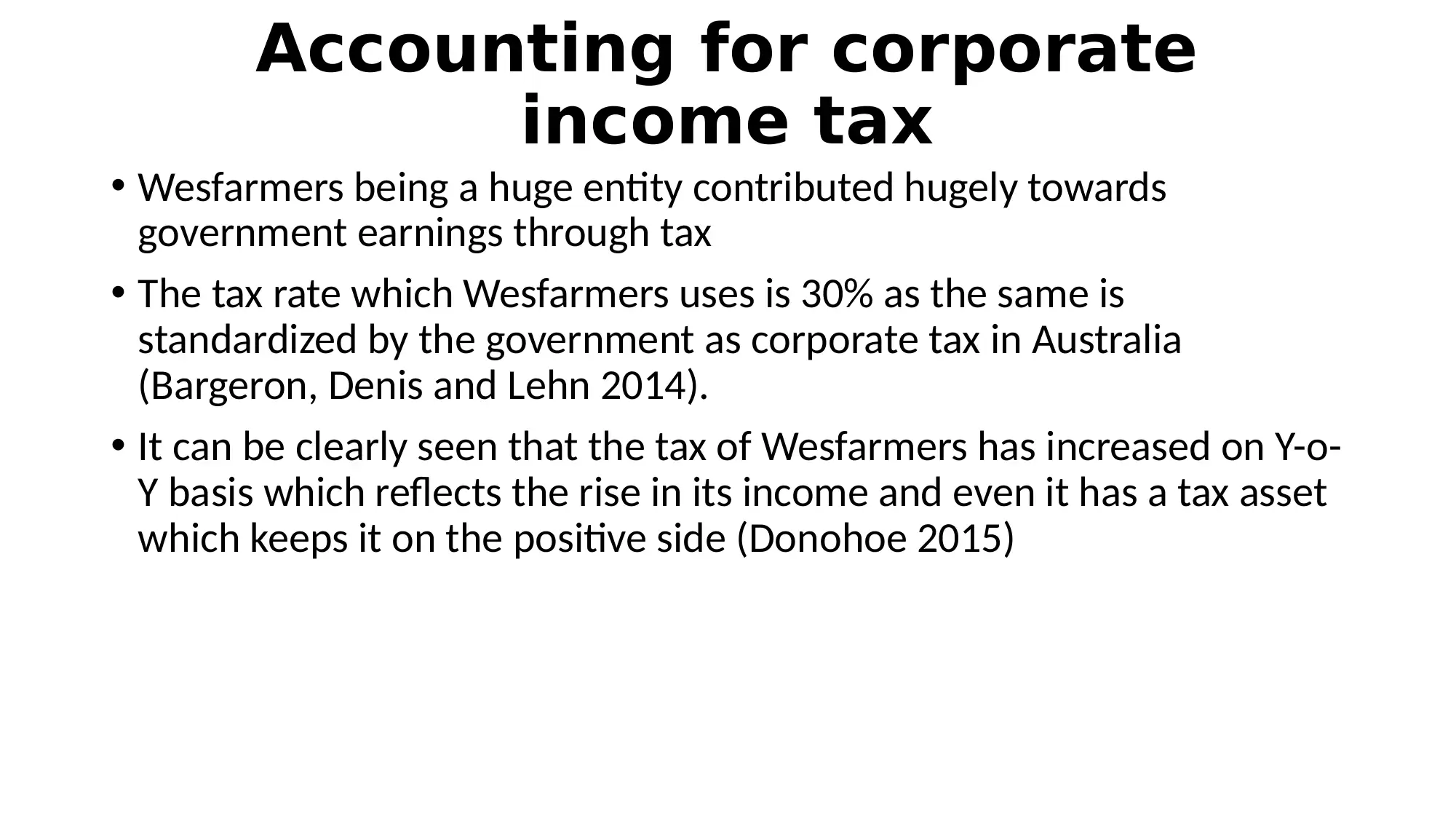
Accounting for corporate
income tax
• Wesfarmers being a huge entity contributed hugely towards
government earnings through tax
• The tax rate which Wesfarmers uses is 30% as the same is
standardized by the government as corporate tax in Australia
(Bargeron, Denis and Lehn 2014).
• It can be clearly seen that the tax of Wesfarmers has increased on Y-o-
Y basis which reflects the rise in its income and even it has a tax asset
which keeps it on the positive side (Donohoe 2015)
income tax
• Wesfarmers being a huge entity contributed hugely towards
government earnings through tax
• The tax rate which Wesfarmers uses is 30% as the same is
standardized by the government as corporate tax in Australia
(Bargeron, Denis and Lehn 2014).
• It can be clearly seen that the tax of Wesfarmers has increased on Y-o-
Y basis which reflects the rise in its income and even it has a tax asset
which keeps it on the positive side (Donohoe 2015)
⊘ This is a preview!⊘
Do you want full access?
Subscribe today to unlock all pages.

Trusted by 1+ million students worldwide

Accounting for corporate
income tax
• In case of Wesfarmers, the deferred tax asset was $971 million in
2017 against $1042 million in 2016
• As per the annual report of Wesfarmers, the company had a tax
liability of $292 million in 2016 against $29 million in 2016
(Balakrishnan, Blouin and Guay 2018)
• In income statement the amount is $1265 million while in cash flow
statement it is $951 million in 2017. The parity is due to consideration
of tax expense including other items in income statement while in
cash flow it is the tax from the earnings from operating activities
income tax
• In case of Wesfarmers, the deferred tax asset was $971 million in
2017 against $1042 million in 2016
• As per the annual report of Wesfarmers, the company had a tax
liability of $292 million in 2016 against $29 million in 2016
(Balakrishnan, Blouin and Guay 2018)
• In income statement the amount is $1265 million while in cash flow
statement it is $951 million in 2017. The parity is due to consideration
of tax expense including other items in income statement while in
cash flow it is the tax from the earnings from operating activities
Paraphrase This Document
Need a fresh take? Get an instant paraphrase of this document with our AI Paraphraser
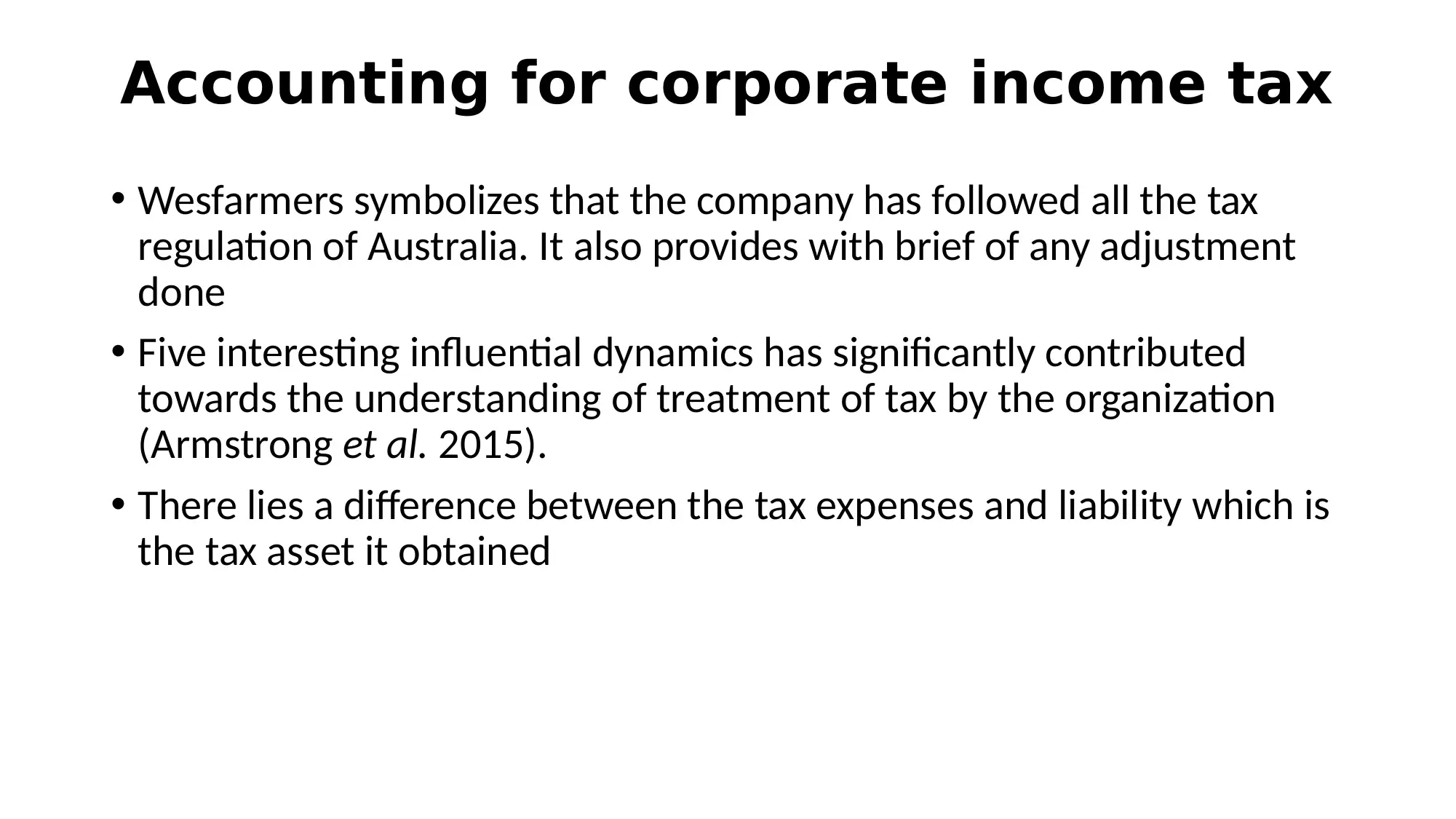
Accounting for corporate income tax
• Wesfarmers symbolizes that the company has followed all the tax
regulation of Australia. It also provides with brief of any adjustment
done
• Five interesting influential dynamics has significantly contributed
towards the understanding of treatment of tax by the organization
(Armstrong et al. 2015).
• There lies a difference between the tax expenses and liability which is
the tax asset it obtained
• Wesfarmers symbolizes that the company has followed all the tax
regulation of Australia. It also provides with brief of any adjustment
done
• Five interesting influential dynamics has significantly contributed
towards the understanding of treatment of tax by the organization
(Armstrong et al. 2015).
• There lies a difference between the tax expenses and liability which is
the tax asset it obtained

References
• Armstrong, C.S., Blouin, J.L., Jagolinzer, A.D. and Larcker, D.F., 2015. Corporate governance, incentives, and tax
avoidance. Journal of Accounting and Economics, 60(1), pp.1-17.
• Balakrishnan, K., Blouin, J. and Guay, W., 2018. Tax Aggressiveness and Corporate Transparency. The
Accounting Review.
• Bargeron, L., Denis, D. and Lehn, K., 2014. Taxes, investment, and capital structure: A study of US firms in the
early 1900s.
• Cazier, R., Rego, S., Tian, X. and Wilson, R., 2015. The impact of increased disclosure requirements and the
standardization of accounting practices on earnings management through the reserve for income
taxes. Review of Accounting Studies, 20(1), pp.436-469.
• De Simone, L., 2016. Does a common set of accounting standards affect tax-motivated income shifting for
multinational firms?. Journal of Accounting and Economics, 61(1), pp.145-165.
• DeBacker, J., Heim, B.T. and Tran, A., 2015. Importing corruption culture from overseas: Evidence from
corporate tax evasion in the United States. Journal of Financial Economics, 117(1), pp.122-138.
• Devereux, M.P., Liu, L. and Loretz, S., 2014. The elasticity of corporate taxable income: New evidence from UK
tax records. American Economic Journal: Economic Policy, 6(2), pp.19-53.
• Donohoe, M.P., 2015. The economic effects of financial derivatives on corporate tax avoidance. Journal of
Accounting and Economics, 59(1), pp.1-24.
• Armstrong, C.S., Blouin, J.L., Jagolinzer, A.D. and Larcker, D.F., 2015. Corporate governance, incentives, and tax
avoidance. Journal of Accounting and Economics, 60(1), pp.1-17.
• Balakrishnan, K., Blouin, J. and Guay, W., 2018. Tax Aggressiveness and Corporate Transparency. The
Accounting Review.
• Bargeron, L., Denis, D. and Lehn, K., 2014. Taxes, investment, and capital structure: A study of US firms in the
early 1900s.
• Cazier, R., Rego, S., Tian, X. and Wilson, R., 2015. The impact of increased disclosure requirements and the
standardization of accounting practices on earnings management through the reserve for income
taxes. Review of Accounting Studies, 20(1), pp.436-469.
• De Simone, L., 2016. Does a common set of accounting standards affect tax-motivated income shifting for
multinational firms?. Journal of Accounting and Economics, 61(1), pp.145-165.
• DeBacker, J., Heim, B.T. and Tran, A., 2015. Importing corruption culture from overseas: Evidence from
corporate tax evasion in the United States. Journal of Financial Economics, 117(1), pp.122-138.
• Devereux, M.P., Liu, L. and Loretz, S., 2014. The elasticity of corporate taxable income: New evidence from UK
tax records. American Economic Journal: Economic Policy, 6(2), pp.19-53.
• Donohoe, M.P., 2015. The economic effects of financial derivatives on corporate tax avoidance. Journal of
Accounting and Economics, 59(1), pp.1-24.
⊘ This is a preview!⊘
Do you want full access?
Subscribe today to unlock all pages.

Trusted by 1+ million students worldwide
1 out of 9
Related Documents
Your All-in-One AI-Powered Toolkit for Academic Success.
+13062052269
info@desklib.com
Available 24*7 on WhatsApp / Email
![[object Object]](/_next/static/media/star-bottom.7253800d.svg)
Unlock your academic potential
Copyright © 2020–2025 A2Z Services. All Rights Reserved. Developed and managed by ZUCOL.



